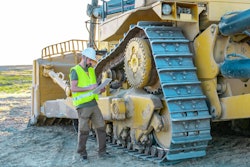
For the third year in a row, InEight, a construction capital project management software developer, has released its Global Capital Projects Outlook.
Once a year, InEight surveys regions and organizations that are involved in the delivery of capital projects.
“Lots of really good signs I think we’re seeing in the industry, some question marks and maybe some red flags as well,” said Brad Barth, chief product officer, InEight.
The report draws insights from research conducted with 300 of the world’s largest capital project owners and contractor construction professionals across North America, Europe, and Asia-Pacific regions.
“It has been a challenging couple of years for construction, with most organizations facing significant supply chain and labor challenges, which have impacted everything from cost to workmanship,” said Jake Macholtz, CEO InEight. “However, those organizations that have remained committed to achieving technology sophistication are reaping the benefits, both for themselves and their clients. The outlook sets out a strong case for all construction organizations to follow in these footsteps, highlighting the many benefits for risk management and communication to project certainty, to name a few.”
The report adds to the growing evidence that the ability to both see and understand the bigger picture through connected data enhances project delivery within the industry.
Positive impacts of connected data
One of the questions answered was about the biggest challenge faced to successfully deliver a project to completion. For contractors, the number one response was access and use of data to understand project status.
Through connected data across project lifecycles, construction firms say they can more astutely identify risk and balance the tradeoffs between scope, cost, and schedule.
Half of the respondents say it improves risk management, while a third said it reduces cost overruns (38%), leads to fewer scope changes (37%) and schedule overruns (33%). It also has a markedly positive impact on employee productivity according to 46% of respondents.
"There's this feeling that there's a lot of information that could come to bear to help make better decisions, help make sure we understand where we're at better," Barth said. "The challenge is collecting that, getting it into a system where you can share it and it makes sense, and its good quality data."
The other piece of the puzzle is adjusting to the sheer amount of data.
“We’ve got all this data, but we don’t necessarily know how to bring it together and how to make sense of it,” Barth said. “It does make sense that would rise to the surface as the number one challenge. I think it also goes back to making that data accessible as the industry continues to grow and tries to keep up with the demand.”
Use of connected data varies by company size with those with the fewest capital projects most likely to report using industry benchmarks (52%) and historic project data (51%) while the largest portfolios are the least likely (43% for benchmarks, 46% for historic project data), possibly due to the greater complexity of integrating new technology software and managing greater volumes of data.
This varied use of connected data is creating a clear divide between the data haves and have-nots with projects much more likely to be completed on or ahead of schedule when industry benchmarks and historic project data were used.
“One of the things that struck me in the report was the idea that just having a project or program management system to help manage whatever undertaking you’re engaged on is now just table stakes,” said Paul Griffiths, senior vice president at AECOM. “It needs to be there. There aren’t many clients out there now who wouldn’t be writing in the need for a fully-fledged set of program management tools into their RFPs.”
He pointed out that the trend demonstrates that across the market, there’s a recognition that without the ability to use technology and manage data, there are going to be downsides in terms of the delivery, either in terms of what gets delivered, the schedule impacts, the quality, the cost overruns, etc.
Griffiths acknowledges there is a shift toward more collaborative models, however, he noted that solid technology to manage the data as well as being able to manage the people issues and the collaboration is needed.
“I think in fact in many ways, it becomes more important to manage data and have the technology and tools to support that collaborative effort with the people and be able to respond flexibly to what’s going on and to the advantage of the project or the program so that you drive the benefits out that way.”
Economist and CEO at Sage Policy Group Anirban Basu agreed that it is important to embrace the technological shift, however, he also pointed to the construction industry’s overall slow ability to adapt.
From a technological standpoint, there have been substantial advances in retail, manufacturing, distribution, and so on over the past several years.
"We've got a challenge here, and construction has been very much behind the productivity curve relative to retail, manufacturing, and other industries," Basu said. "The typical construction jobsite, at least in the U.S., looks very much like it looked several decades ago."
Compared to other industries, he suggested there has been weak productivity growth in construction.
“At the heart of the issue is that we have a construction workforce that has a difficult time simply mastering existing technologies and processes,” he said. “When you’ve got an industry that needs to embrace change, which you don’t have the workers that can embrace change, you end up being pretty static in terms of productivity growth.”
The key, per the report, is improving collaboration.
"It's clear that we are moving to a stage where using technology, people can properly take on the mantra of reporting something that happened a month ago, and telling me how you intend to fix it next month is just not going to cut it," said Jeff Quantrill, head of account management at EMEA for InEight. “You’ve got to get to a point where you are looking at what is going to happen in the next week, what are the blockers to that and how are you going to prioritize your resources and your management expertise to deliver that.”
Quantrill sees the shift to share data collaboratively as being huge for the construction industry.
He believes that as the concept advances, it will revolutionize where things are going in the next five to 10 years.
A challenging environment
Respondents remain very positive about the overall outlook for the industry, despite the various challenges it currently faces.
Barth noted that a variety of issues from COVID, the Ukraine conflict, and extreme weather events have forced the industry to work a bit differently across the globe.
“I think some of those things have blown a hole in the status quo and forced all of us to work a little bit differently,” he said.
Despite a challenging operating environment, optimism has remained high for a third year in a row (92% in 2021, 96% in 2022, and 94% in 2023) with digital technologies, economic growth/recovery, and sustainable building projects identified as key areas of growth. Construction and capital project spending levels continue to trend upwards, with 86% reporting an increase compared to 76% in 2022 and 68% in 2021.
This positivity is somewhat tempered by a significant rise in concerns over labor challenges. Concerns over staff and skills shortages were identified as a risk to growth by 42% – not only entering the top three risks for respondents for the first time but also taking the top spot. Yet, even with an intensifying skills shortage, along with disruption caused by cost inflation and supply chain delays, industry confidence remains high this year, with those feeling somewhat or very resilient slightly increasing from 91% in 2022 to 92% in 2023.
Basu expressed surprise at the continued optimism within the industry.
From an economic point of view, typically the ongoing rising capital costs would slow the interest-rate sensitive segments such as construction.
“Money has become much more expensive,” he said. “It’s become more difficult to access, including in North America with the failures of Silicon Valley Bank and Signature Bank and First Republic Bank being taken up by JP Morgan, all of that. Capital is more expensive.”
Basu said that one of the most surprising aspects of confidence within the construction and capital projects marketplace is the appearance of minimal impact of the increased interest rates.
Regardless of InEight’s survey results, the economist noted that for construction companies invested in infrastructure, particularly in the U.S., there is a likelihood of being busy.
“If you’re a contractor that’s wedded to commercial construction, at least in the United States, the outlook is not particularly positive,” he said. “We have a real commercial real estate challenge in front of us.”
The rising number of office vacancy rates and abandoned or vacant shopping centers are only more negatives for the industry.
“That frustrates new construction, and on top of that, not only has the cost of capital-facing developers increased, but it’s more difficult for them to access capital,” he added.
In addition, Basu pointed out that senior lending officials at senior banks are currently trying to limit their exposure to commercial real estate.
He said approximately $1.5 trillion of commercial real estate-related debt needs to be refinanced between now and the end of 2025.
“Who’s going to refinance that debt? Project financing and commercial real estate is going to become a real challenge,” Basu said. A similar challenge will be faced within the multifamily or apartment construction category.
“Those contractors that are aligned with developer-driven activities stand to be very challenged in the year ahead or the next couple of years, at least, relative to contractors that specialize on infrastructure or megaprojects like major manufacturing facilities or healthcare facilities,” Basu said “It’s going to be a very disparate performance across contractors. Some contractors are going to fare very well going forward, will have more work than they know what to do with while other contractors face their idiosyncratic recessions over the next two to three years."
While optimism remains, one of the biggest challenges is getting the people needed with the right level of skill and experience while also using technology to supplement that.
The labor issue remains the number one concern with other significant issues being stagnation or recession (40%), poor data collection and analytics, (41%), and the political climate (28%).
Nearly three-quarters of respondents (74%) report cost inflation as disruptive, and 70% cite delays and disturbances in the supply chain. On the labor side, 68% point to pay inflation, and 64% point to the related issue of labor and recruitment challenges.
Many respondents say their organizations are using technology to understand and engage with the big-picture operating environment. The use of project management or project control software is the most popular (58%), while many organizations also use artificial intelligence and machine learning (50%), risk-adjusted project planning software (47%), and connected worksite communication (47%).
As indicated by the report and other surveys, one of the ways to work differently is by improving methods of staying on schedule through the use of historic data and benchmarks as an average.
"I think the overall optimism is holding strong," Barth said. "This is the third year we've done this survey, and an interesting thing is one of the things we asked is the spending. Are you seeing spending increase, decrease, or stay the same?"
According to the survey, the spending has increased by nearly 10 percentage points annually. Up to 86% of respondents recognized or is observing an increase in spending, which is about 10% lower than last year.
“It’s on a nice upward trend, which I think reflects the overall optimism that we’re seeing,” Barth said, noting that there continues to be a growing focus on technology.
“I think is we’re seeing in the industry is getting more collaborative through contract models and otherwise driving more collaboration, more visibility to data and information,” he said. “I think that’s driving a lot of technology adoption.”














